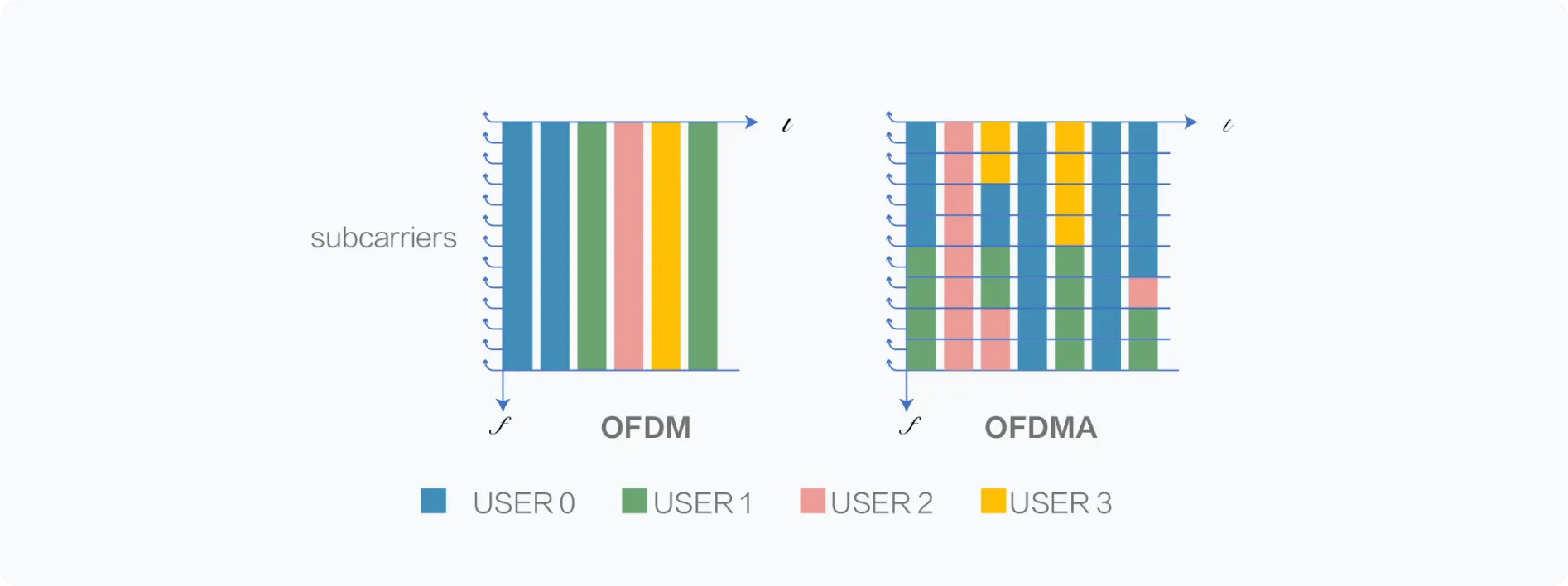Ruijie Networks Wi-Fi 7
Advantages of Wi-Fi 7 Over Wi-Fi 6
4096-QAM Modulation
Wi-Fi 6 supports up to 1024-QAM, encoding 10 bits per symbol. Wi-Fi 7 advances to 4096-QAM, encoding 12 bits per symbol—1.2 times more efficient than Wi-Fi 6, enabling higher data transfer in each symbol.

320 MHz Channel Bandwidth
Wi-Fi 7 introduces a significant leap in channel bandwidth, doubling the capacity of Wi-Fi 6. While Wi-Fi 6 operates with a maximum of 1960 valid sub-carriers on a 160 MHz channel, Wi-Fi 7 expands to 3920 valid sub-carriers on a 320 MHz channel. This enhancement allows Wi-Fi 7 to transmit twice as many data streams simultaneously compared to Wi-Fi 6.
To visualize, imagine a highway. In Wi-Fi 6, a 160 MHz channel acts like a road with 1960 lanes, each lane representing a sub-carrier for data transmission. Wi-Fi 7, with its 320 MHz channel, transforms the highway into one with 3920 lanes, effectively doubling the traffic capacity. This improvement translates into faster speeds, higher throughput, and better performance, especially in high-density scenarios or data-intensive applications.
Multi-Link Operation (MLO)
Multi-Link Operation (MLO) leverages multiple radio frequency (RF) chips within a single access point (AP), encompassing 2.4 GHz, 5 GHz, and 6 GHz bands. This technology enables an AP’s multiple chips to establish simultaneous connections with a single station (STA). By creating multiple RF data transmission links between an AP and STA, MLO significantly boosts data transfer speeds, minimizes latency, and ensures more reliable data transmission, enhancing overall network performance.

Preamble Puncturing
Preamble puncturing optimizes channel utilization by masking out auxiliary channels affected by interference while allowing the remaining channels to continue transmitting data seamlessly. This technology ensures that non-continuous channels are utilized effectively, enhancing overall network performance and reliability.
Multiple Resource Unit (MRU)
Wi-Fi 6 brought in Resource Units (RU), enabling simultaneous data transmission to multiple users, though limited to one RU per user. Wi-Fi 7 advances this with Multiple Resource Unit (MRU) technology, allowing multiple RUs to be allocated to a single user for concurrent data transfer. This innovation enhances channel resource utilization and boosts transmission efficiency.

Unique Values of Ruijie Networks Wi-Fi 7
Scenario-based Smart Antennas
Ruijie Wi-Fi 7 APs feature adaptive signal radiation adjustment, enhancing signal strength and extending coverage for clients. The high-frequency band incorporates a dual-polarized omnidirectional antenna (horizontal and vertical) to boost non-correlation and improve co-frequency antenna isolation, significantly minimizing interference. These smart antennas optimize Wi-Fi performance, delivering an improved user experience in high-density environments.
Spectrum Reservation and Air Interface Scheduling
In the frequency domain, frequency reservation allocates dedicated frequency resources within the air interface for critical services, ensuring service reliability. Think of frequency reservation like a dedicated bus lane—other vehicles are not allowed to use this lane, guaranteeing the speed and efficiency of the buses.
Independent Dual-AI Radio Scanning
Ruijie Networks Wi-Fi 7 APs feature dual built-in AI radios for dedicated scanning on the 2.4 GHz and 5 GHz bands. Equipped with advanced roaming technology, these AI radios optimize roaming-out handovers and roaming-in decisions. They precisely guide client devices to connect with the best AP, delivering a seamless roaming experience with an average handover latency of under 10ms. This ensures smooth performance for critical applications like mobile video streaming and automated guided vehicles (AGVs).

Digital-Twin-based O&M
Telemetry-based data collection technology allows videos to be captured with precision in seconds, supporting a scale of over 50,000 devices. Leveraging big data and AI, digital twin modeling provides real-time insights into changes in each user’s network experience. The digital twin O&M map offers intelligent functionalities like visual fault localization for Wi-Fi devices, local network optimization, service network enhancement, and VIP area optimization. These features significantly improve the efficiency and user experience of Wi-Fi network operations and maintenance (O&M).

In the time domain, air interface scheduling identifies critical or VIP services and prioritizes them in the queue, enhancing the Wi-Fi experience for VIP clients. This is similar to how other vehicles give way to emergency vehicles like ambulances and police cars on the road, ensuring they have priority passage.
What is Wi-Fi 7?
The Wi-Fi Alliance is preparing to launch the next-generation Wi-Fi technology standard, IEEE 802.11be, in early 2024. Following the established naming convention, this new standard will be known as Wi-Fi 7.
When will Ruijie Networks Wi-Fi 7 APs be available?
In 2022, Ruijie Networks became one of the first vendors to unveil Wi-Fi 7-based AP products, showcased at the Gulf Information Technology Exhibition (GITEX) Global in Dubai.
In July 2023, Ruijie Networks introduced their latest Wi-Fi 7 AP, the RG-AP9850-R, in China.
Is the commercial environment for Wi-Fi 7 mature? Which application scenarios will be the first to adopt Wi-Fi 7?
With the gradual opening of 6 GHz frequency bands, Wi-Fi 7 is being adopted in various commercial scenarios. It supports high data rate and low latency applications such as AR, VR, metaverse, cloud gaming, ultra-high-definition video, and advanced manufacturing. The technology is also preferred in high-security environments like banking and high-density areas demanding exceptional Wi-Fi performance.
